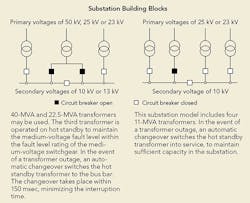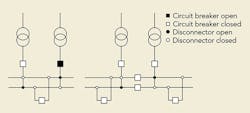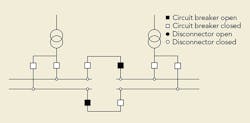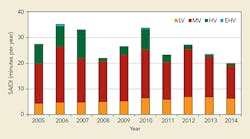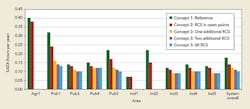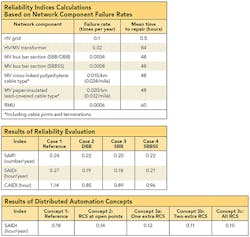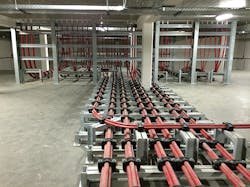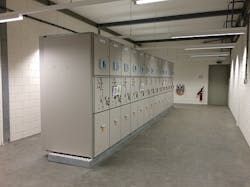Analysis Drives Future Substation Configurations
Stedin Netbeheer B.V. is a regional network operator responsible for the transmission and distribution of electricity in Randstad, a large urban area in western Netherlands. More than 2 million customers are supplied by Stedin in this area, which includes the cities of The Hague, Rotterdam and Utrecht. Stedin was formed by a merger of former municipal network operators that had different design philosophies on network structures, voltage levels and substation layouts. As a result, the layouts of Stedin substations commissioned between the 1960s and 1980s differ widely.
Stedin’s high-voltage (HV) subtransmission network operates at 50 kV and 25 kV, with medium-voltage (MV) distribution network voltages of 23 kV (as of 1990), 13 kV and 10 kV. Apart from three 50-kV overhead lines, the HV and MV connections consist of underground cables.
Aging switchgear in need of replacement presents the utility with an opportunity to re-evaluate the design and configuration of its current HV and MV substations while simultaneously exploring possibilities for integrating distribution automation into its MV network. Switchgear replacement is linked to controlling the risk of aging assets no longer supported by the original equipment manufacturer, now or in the near future. This risk involves mainly minimum oil breakers installed in 35% of all bays in the HV and MV substations. Stedin has decided to pursue a two-track approach that involves the replacement of minimum oil breakers switchgear over a 20-year period plus conservation of switchgear not replaced during that time, in cooperation with the successor to the original equipment manufacturer.
Substation Layouts
A substation replacement gives Stedin an opportunity to re-evaluate the layout and consider a standardized layout. To define standard substation layouts, a distinction was made between the bus bar concept and the maximum number of transformers to be installed, all of which affect substation capacity.
The approach chosen for determining the maximum number of transformers and the substation capacity is based on basic building blocks consisting of a fixed transformer capacity and a fixed short-circuit current. These building blocks are specified so the nominal bus bar current and the short-circuit current contribution comply with the design parameters of the available MV switchgear. The acceptable fault level of the existing ring main units must be considered.
The building blocks for substations are as follows:
• 50-kV/10-kV or 50-kV/13-kV substations, two or three 40-MVA transformers, 15% impedance
• 25-kV/10-kV and 23-kV/10-kV substations, three 22.5-MVA transformers, 12% impedance
• 25-kV/10-kV and 23-kV/10-kV substations, four 11-MVA transformers, 10% impedance.
The limitation on the capacity per substation is linked to the impact a complete substation outage has on Stedin’s performance.
Bus Bar Concepts
The substation layout and bus bar configuration have an important role in security of supply, operational flexibility and costs. These are the most common bus bar concepts for voltages below 150 kV:
• Single-section single bus bar (SBBSS) — The simplest and cheapest bus bar configuration concept (concept 1) is SBBSS. Because of its simplicity, errors in switching operations are minimal. An extension or repair to the bus bar, once commissioned, is not possible without de-energizing the complete bus bar.
• Two-section SBB — A natural extension of the single-section bus bar concept is the two-section SBB (concept 2). A transformer is connected to each section, and the sections can be coupled by a bus bar coupler circuit breaker.
• Single-section double bus bars (DBB) — This concept (concept 3) overcomes the drawback of the SBBSS concept as each bus bar has two bus disconnectors that facilitate the connection of each feeder to either of the two bus bars.
• Two-section DBB — This concept (concept 4) can be extended further by adding a second section. Both sections can be coupled by a coupling breaker between the sections, and both buses can be coupled by a coupling breaker between the buses.
• Four SBB — This concept (concept 5) consists of four SBB that can be paired up and coupled by a coupling breaker. A maximum of two transformers can be applied, and two bus bar sections are connected to each transformer. Because of the transformer division over two SBB sections, larger transformer capacities can be accommodated.
After a multicriteria analysis and discussion on substation and bus bar concepts — involving 20 experts from various relevant technical departments — Stedin formulated a design rule: New switchgear would be divided into a two-section SBB, installed in separate rooms. A reliability study of the new design rule was undertaken with the Gorinchem substation.
The Design Study
The substation configurations have been studied for an HV/MV substation in the town of Gorinchem, where the existing MV switchgear needs to be replaced. The substation configurations and distribution grid adaptions were evaluated by means of reliability calculations.
Within Stedin, the customer interruption time and frequency should be as low as possible, subject to reasonable costs. At the substation level, this is done by optimizing the substation configuration for the feeding infrastructure of the distribution network. Optimization is achieved by removing and replacing aged satellite switching stations and transforming complicated meshed network structures into radially operated ring structures. Additional reliability improvements can be achieved through remote-controlled switches (RCS).
Reliability Indicators and Assessment
In this study, the system average interruption frequency index (SAIFI), system average interruption duration index (SAIDI) and customer average interruption duration index (CAIDI) are used. The development of SAIFI and SAIDI values in the Netherlands over the last 10 years show the MV distribution network has large contributions to both indices.
The reliability assessments were done within a software package. The distribution grid in the Gorinchem area was modeled to consider various MV substation configurations.
To secure redundancy in the distribution network, the distribution feeders must start from one bus bar section and end at the other bus bar section. Hence, as a consequence of the design rule, some distribution feeders in the distribution grid of Gorinchem had to be adapted to meet this requirement.
Substation Configuration
With the aid of the distribution network modeling, various substation configurations can be evaluated. The proposed MV switchgear configurations were SBBSS, two-section SBB and two-section DBB.
Initially, the current substation configuration of Gorinchem had a DBB configuration with four assessment cases:
• Reference case, no changes made to both the current substation configuration and current distribution network
• Substation configured as a two-section DBB combined with the restructured distribution network
• Substation configured as a two-section SBB combined with the restructured distribution network
• Substation configured as a SBBSS combined with the restructured distribution network.
The reliability calculations of these four cases incorporated various network component failure rates from experience and were focused on reliability of the MV network; therefore, the LV network was excluded from the calculations.
Distribution Automation
During the study on Gorinchem’s MV distribution grid, implementation of distribution automation was considered. A RCS contains a remote fault passage indicator so the control center can quickly identify the location a faulted component. The switch can be controlled remotely by an operator in the control center, instead of locally, reducing travel and localization time. Hence, it has a positive impact on CAIDI and SAIDI.
Results of Reliability Evaluation
The reliability evaluation showed the overall effect of the distribution grid adaptions resulted in a 30% decrease in SAIDI. According to the design rule, the two-section SBB has a slightly better SAIDI (5%) than the next best option, the two-section DBB.
The results show restructuring the distribution grid led to a SAIDI reduction overall of about 30% (from 16 minutes per year to 11 minutes per year), but the distribution network improvements do not have an equal effect on all areas.
Two-section bus bar configurations have lower SAIDI values than the one-section configuration. In the latter case, a bus bar failure causes a total substation outage, because of the lack of redundancy. Such bus bar failures are an event with a high impact and low probability. The SAIFI values for DBB and SBB configurations are lower because the transformers operate in parallel (in separate sections), while for the SBBSS, one transformer is operated in a hot standby mode.
The reliability evaluation for the DBB configuration results in extra time being incorporated because the healthy bus bar will be visually inspected first to ensure it is not damaged by the failure of the other bus bar. After the inspection, all feeders will be switched over sequentially to the healthy bus bar using the disconnectors and circuit breakers. For the SBB configuration, a bus bar failure needs no visual inspection since both sections are architecturally divided, minimizing possible damage to the second section. However, switching over the involved feeders to the healthy section is done by closing the normally open points in the distribution network, a procedure that takes more time.
Impact of Distribution Automation
The results of distribution automation are shown by comparison of SAIDI values, because RCS only accelerate the fault localization and decrease restoration duration while the SAIFI remains unchanged.
Comparison of the SAIDI values show the more RCS introduced in the network, the larger the impact, but the additional reliability benefit per additional RCS is quickly saturated. For the Gorinchem distribution network, with a maximum of about 10 ring main units per open ring feeder, the highest quantitative impact is obtained by placing a RCS at the open points in the distribution network and, eventually, placing one extra RCS halfway down each feeder (concepts 2 and 3).
Impact of Substation Configurations
The impact of substation configurations has shown it is preferable to divide the switchgear into two redundant sections and install them in separate rooms. Next to that, the two-section SBB concept is rewarded slightly higher than the two-section DBB concept. Therefore, it can be concluded the substation configuration has little impact on the reliability indices. Comparing the results of the SBB and DBB configurations shows the SBB configuration performs slightly better with a 5% lower SAIDI.
Therefore, in view of this small difference, the capital and maintenance costs become important. Taking these costs as well as the reliability indices into account, it is cost-effective to apply the SBB configuration. Comparing the SBBSS configuration with the two-section alternative indicates the approach of two sections positioned in separate rooms is a valid design rule in substation planning.
Furthermore, because of the small differences in the results, it can be concluded that the majority of the contribution to the reliability indices comes from the distribution network. A prerequisite for the two-section substation design, the distribution network should be adapted such that it can be divided in two sections to meet the redundancy requirements. Also, the largest reduction in SAIDI is obtained by automating the normally open points. Further reduction can be achieved by automating a switch in the middle of a feeder. Automating more switches will lead to an increase in costs, but the contribution to a reduction in SAIDI quickly declines.
Dirk Boender obtained a MSEE degree in 1985 from the Delft University of Technology and then worked for 13 years in a high-voltage cable factory. Since 2006, Boender has worked within Stedin Netbeheer B.V. on asset management policies and strategies concerning all switchgear installed in high-voltage/medium-voltage substations. In September 2015, Boender joined the Siemens’ Expert Centre High Voltage in Amersfoort, the Netherlands.
Edward Coster was awarded a BSEE degree from TH Rijswijk in 1997 and a MSEE degree from Delft University of Technology in 2000. He joined Stedin Netbeheer B.V. in 2000 as a specialist for network planning. In 2006, Coster joined the electrical power system group at Eindhoven University of Technology to start a Ph.D. research project, which he obtained in 2010. Currently, he is a network strategist in the network strategy department. His main fields of interest include distributed generation, power system protection, distribution automation, dynamic behavior and stability of power systems.
Bram Staarink completed his sustainable energy technology studies with a master’s degree from Eindhoven University of Technology in 2015. He did his graduate project at grid operator Stedin Netbeheer B.V., focusing on the design and configuration of current high-voltage/medium-voltage substations and simultaneously exploring possibilities for integrating distribution automation into the utility’s medium-voltage network. Staarink joined Alliander, another grid operator in the Netherlands, following his graduation.

